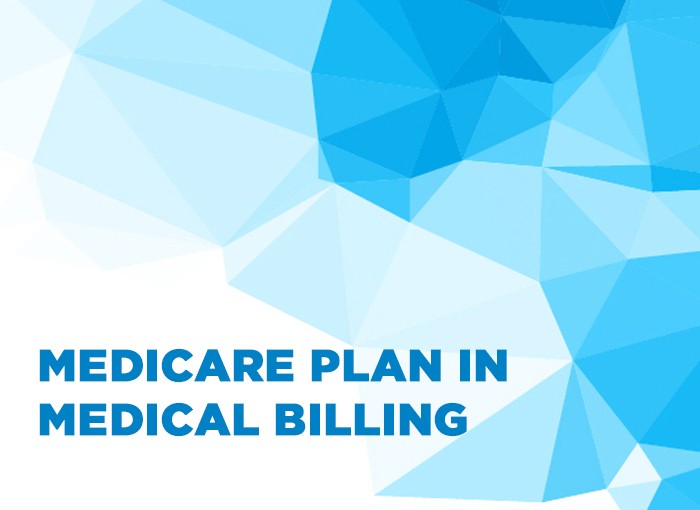How does a Medicare plan work in medical billing?
Medicare is the federal health insurance program designed to provide medical benefits to US citizens of age 65 and older, or people with certain disabilities or illness, and with End-Stage Renal Disease. Medicare has different parts to cover specific medical services.
Knowing each part in detail will allow you to understand how it works.
Medicare Part A (Hospital Insurance)
This part covers In-patient services, hospice, skilled nursing facility care, and home health care.
Medicare Part B (Medical Insurance)
This part covers Out-patient services and medically essential services or supplies that are required to treat every medical condition as per accepted medical standards. Some of the services that can be included are doctor visits, lab tests, certain vaccinations, and durable medical equipment.
Medicare Part C (Medicare Advantage Plan)
This part allows you to get coverage under Original Medicare through a Medicare-approved private insurance company. With Medicare Advantage plans, you can enjoy all the benefits of Part A and Part B except hospice. These plans also provide prescription drug coverage. It’s probably the only single plan that gives you all Medicare benefits.
Medicare Part D (prescription drug coverage)
This part allows you to cover the cost of prescription drugs (including certain recommended shots or vaccines).
Original or Traditional Medicare is not designed to cover everything. Some of the things that Medicare does not cover are – Acupuncture, Long-term care or nursing home care, Personal nursing, Routine vision care, including eye exams, glasses, and contact lenses, Routine dental care, including cleanings and fillings, dentures as well as cosmetic surgery and hearing aids.
Usually, you have to pay the entire cost for health care services that are not covered by the Original Medicare. However, Medicare Advantage plans may include coverage for some services that Original Medicare doesn’t pay for, such as routine vision or dental, or hearing care.
How does a Medicare plan work?
Interestingly, you can choose the way you want to get covered under Medicare. First, you need to check if you are eligible for Medicare or not. If you are, you need to enrol in it. Post that, you can decide how you wish to receive your Medicare coverage. The two main ways to get covered are-
1. Original Medicare
It includes Medicare Part A (Hospital Insurance) and Medicare Part B (Medical Insurance). You may need to pay a copayment (a flat dollar amount you need to pay for certain services), coinsurance (a percentage of the treatment cost), and/or a deductible (an annual amount you pay before your Medicare program starts to pay). For Medicare Part B, the coinsurance is 20% of the treatment cost.
You can also include a separate drug plan if you want drug coverage. A provider charges you as per the fee schedule list approved by the Medicare program. The list has provider reimbursement rates for each service.
2. Medicare Advantage
It’s more convenient as compared to Original Medicare. It usually combines the benefits of Medicare Part A, Part B, and usually Part D. You have an idea about the out-of-pocket cost in this type of Medicare coverage. There may be different out-of-pocket costs for each Medicare Advantage plan.
Medicare prescription drug coverage (Part D)
You need to join a Medicare-approved plan that offers drug coverage to get Medicare drug coverage (including Medicare drug plans and Medicare Advantage Plans with drug coverage). The cost and the drugs covered may vary with each plan. The out-of-pocket cost depends on the plan you choose.
Filing Medicare claims
The process of filing a Medicare claim depends on the Medicare coverage you choose. The rules to submit a claim for Original Medicare (Part A and Part B) are different from Medicare Part C and Medicare Part D because Medicare-approved private insurance companies provide coverage for the latter two parts.
- Medicare claims for Original Medicare
Doctors or other health care providers need to submit the Original Medicare claim within one calendar year (12 months) after the medical services are rendered. The Medicare program directly pays the providers for the services provided. Medicare is not liable to pay its share if the claim is not received in time.
If you receive health care services from a Medicare-participating provider, the provider would file the claim for you. If the provider is a non-participating doctor, you would need to pay the entire cost upfront and file the claim for reimbursement.
- Medicare claims for Medicare Advantage and Medicare Prescription Drug Plans
For Part C and Part D, you do not need to submit claims to Medicare as the Medicare program reimburses Medicare Advantage Plan and Medicare Prescription Drug Plan directly by paying the participating providers a set monthly amount. If your plan has a network and you visit an out-of-network provider, you may need to file a Medicare claim yourself and bear out-of-pocket costs.




